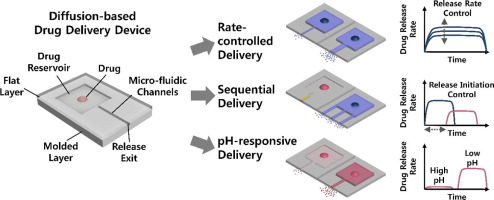Acta Biomaterialia ( IF 9.4 ) Pub Date : 2017-12-18 , DOI: 10.1016/j.actbio.2017.12.013 Dasom Yang , Jung Seung Lee , Chang-Kuk Choi , Hong-Pyo Lee , Seung-Woo Cho , WonHyoung Ryu

|
Controlled delivery of drug at a constant rate, in a sequential order, or responsive to environment conditions has been pursued for a long time to enhance the efficacy of therapeutic molecules and to minimize side effects of highly potent drugs. However, achieving such delicately-controlled delivery of a drug molecule is non-trivial and still remains a challenge. We propose the use of microchannels to control the rate, sequence, and pH-responsiveness of drug delivery for high precision and predictability. In this study, we introduce elementary drug delivery units consisting of micro-reservoirs and microchannels that have variations in their lengths, widths, numbers, and straightness. The release study demonstrates that the release rates of model drugs can be modulated by the design of microchannels. Finite element modeling of drug release predicts the performance of the drug delivery units with high accuracy. The possibility of sequential drug delivery is also demonstrated using biodegradable polymer plug in microchannels. Finally, pH-responsive delivery of drugs in microfluidic units is also discussed and demonstrated via cell viability tests.
The Statement of Significance
In this work, we developed microchannel-based drug delivery devices whose release rate could be accurately calculated and controlled by design of microchannel geometry. Although there have been many advances in microfabricated drug delivery systems, in particular, reservoir-based systems, no systematic investigation has been made to utilize the release channels. In our work, an equivalent electrical circuit concept was applied to the microfluidic systems for more detailed design and analysis. A microfluidic channel was regarded as an electrical resistor; their diffusion/electrical flux could be tuned with geometric factors such as length, width, a number of channel/resistor and their connections. Furthermore, from delivery rate control using channel geometry, multifunctional channel-based release systems for sequential and pH-responsive were demonstrated.
中文翻译:

用于速率控制,顺序和pH响应药物递送的微通道系统
长期以来一直追求以恒定的速率,顺序的顺序或对环境条件的响应来控制药物的输送,以增强治疗分子的功效并最大程度地降低强效药物的副作用。然而,实现药物分子的这种精细控制的递送并非易事,并且仍然是挑战。我们建议使用微通道来控制药物输送的速率,序列和pH响应性,以实现高精度和可预测性。在这项研究中,我们介绍了由微储器和微通道组成的基本药物输送单元,它们的长度,宽度,数量和直线度都有变化。释放研究表明,可以通过设计微通道来调节模型药物的释放速率。药物释放的有限元建模可以高度准确地预测药物输送单元的性能。在微通道中使用可生物降解的聚合物塞也证明了顺序给药的可能性。最后,还讨论了微流控单元中pH响应型药物的递送,并通过细胞活力测试进行了证明。
重要声明
在这项工作中,我们开发了基于微通道的药物输送装置,其释放速率可以通过微通道几何结构的设计准确地计算和控制。尽管微加工的药物输送系统,特别是基于储库的系统已取得了许多进步,但尚未进行系统的研究以利用释放通道。在我们的工作中,将等效电路概念应用于微流体系统,以进行更详细的设计和分析。微流体通道被认为是电阻器。它们的扩散/电通量可以通过几何因素进行调整,例如长度,宽度,通道/电阻器的数量及其连接。此外,通过使用渠道几何结构进行投放速度控制,











































 京公网安备 11010802027423号
京公网安备 11010802027423号